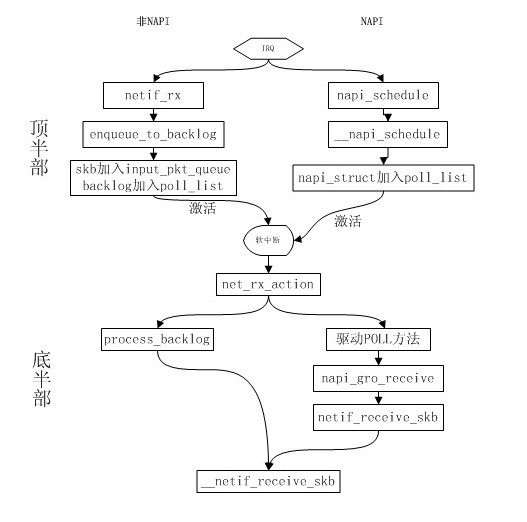資料包接收系列 — NAPI的原理和實現
本文主要內容:簡單分析NAPI的原理和實現。
核心版本:2.6.37
Author:zhangskd @ csdn
概述
NAPI是linux新的網絡卡資料處理API,據說是由於找不到更好的名字,所以就叫NAPI(New API),在2.5之後引入。
簡單來說,NAPI是綜合中斷方式與輪詢方式的技術。
中斷的好處是響應及時,如果資料量較小,則不會佔用太多的CPU事件;缺點是資料量大時,會產生過多中斷,
而每個中斷都要消耗不少的CPU時間,從而導致效率反而不如輪詢高。輪詢方式與中斷方式相反,它更適合處理
大量資料,因為每次輪詢不需要消耗過多的CPU時間;缺點是即使只接收很少資料或不接收資料時,也要佔用CPU
時間。
NAPI是兩者的結合,資料量低時採用中斷,資料量高時採用輪詢。平時是中斷方式,當有資料到達時,會觸發中斷
處理函式執行,中斷處理函式關閉中斷開始處理。如果此時有資料到達,則沒必要再觸發中斷了,因為中斷處理函
數中會輪詢處理資料,直到沒有新資料時才打開中斷。
很明顯,資料量很低與很高時,NAPI可以發揮中斷與輪詢方式的優點,效能較好。如果資料量不穩定,且說高不高
說低不低,則NAPI則會在兩種方式切換上消耗不少時間,效率反而較低一些。
實現
來看下NAPI和非NAPI的區別:
(1) 支援NAPI的網絡卡驅動必須提供輪詢方法poll()。
(2) 非NAPI的核心介面為netif_rx(),NAPI的核心介面為napi_schedule()。
(3) 非NAPI使用共享的CPU佇列softnet_data->input_pkt_queue,NAPI使用裝置記憶體(或者
裝置驅動程式的接收環)。
(1) NAPI裝置結構
/* Structure for NAPI scheduling similar to tasklet but with weighting */ struct napi_struct { /* The poll_list must only be managed by the entity which changes the * state of the NAPI_STATE_SCHED bit. This means whoever atomically * sets that bit can add this napi_struct to the per-cpu poll_list, and * whoever clears that bit can remove from the list right before clearing the bit. */ struct list_head poll_list; /* 用於加入處於輪詢狀態的裝置佇列 */ unsigned long state; /* 裝置的狀態 */ int weight; /* 每次處理的最大數量,非NAPI預設為64 */ int (*poll) (struct napi_struct *, int); /* 此裝置的輪詢方法,非NAPI為process_backlog() */ #ifdef CONFIG_NETPOLL ... #endif unsigned int gro_count; struct net_device *dev; struct list_head dev_list; struct sk_buff *gro_list; struct sk_buff *skb; };
(2) 初始化
初始napi_struct例項。
void netif_napi_add(struct net_device *dev, struct napi_struct *napi,
int (*poll) (struct napi_struct *, int), int weight)
{
INIT_LIST_HEAD(&napi->poll_list);
napi->gro_count = 0;
napi->gro_list = NULL;
napi->skb = NULL;
napi->poll = poll; /* 裝置的poll函式 */
napi->weight = weight; /* 裝置每次poll能處理的資料包個數上限 */
list_add(&napi->dev_list, &dev->napi_list); /* 加入裝置的napi_list */
napi->dev = dev; /* 所屬裝置 */
#ifdef CONFIG_NETPOLL
spin_lock_init(&napi->poll_lock);
napi->poll_owner = -1;
#endif
set_bit(NAPI_STATE_SCHED, &napi->state); /* 設定NAPI標誌位 */
}
(3) 排程
在網絡卡驅動的中斷處理函式中呼叫napi_schedule()來使用NAPI。
/**
* napi_schedule - schedule NAPI poll
* @n: napi context
* Schedule NAPI poll routine to be called if it is not already running.
*/
static inline void napi_schedule(struct napi_struct *n)
{
/* 判斷是否可以排程NAPI */
if (napi_schedule_prep(n))
__napi_schedule(n);
}
判斷NAPI是否可以排程。如果NAPI沒有被禁止,且不存在已被排程的NAPI,
則允許排程NAPI,因為同一時刻只允許有一個NAPI poll instance。
/**
* napi_schedule_prep - check if napi can be scheduled
* @n: napi context
* Test if NAPI routine is already running, and if not mark it as running.
* This is used as a condition variable insure only one NAPI poll instance runs.
* We also make sure there is no pending NAPI disable.
*/
static inline int napi_schedule_prep(struct napi_struct *n)
{
return !napi_disable_pending(n) && !test_and_set_bit(NAPI_STATE_SCHED, &n->state);
}
static inline int napi_disable_pending(struct napi_struct *n)
{
return test_bit(NAPI_STATE_DISABLE, &n->state);
}
enum {
NAPI_STATE_SCHED, /* Poll is scheduled */
NAPI_STATE_DISABLE, /* Disable pending */
NAPI_STATE_NPSVC, /* Netpoll - don't dequeue from poll_list */
};
NAPI的排程函式。把裝置的napi_struct例項新增到當前CPU的softnet_data的poll_list中,
以便於接下來進行輪詢。然後設定NET_RX_SOFTIRQ標誌位來觸發軟中斷。
void __napi_schedule(struct napi_struct *n)
{
unsigned long flags;
local_irq_save(flags);
____napi_schedule(&__get_cpu_var(softnet_data), n);
local_irq_restore(flags);
}
static inline void ____napi_schedule(struct softnet_data *sd, struct napi_struct *napi)
{
/* 把napi_struct新增到softnet_data的poll_list中 */
list_add_tail(&napi->poll_list, &sd->poll_list);
__raise_softirq_irqoff(NET_RX_SOFTIRQ); /* 設定軟中斷標誌位 */
}
(4) 輪詢方法
NAPI方式中的POLL方法由驅動程式提供,在通過netif_napi_add()加入napi_struct時指定。
在驅動的poll()中,從自身的佇列中獲取sk_buff後,如果網絡卡開啟了GRO,則會呼叫
napi_gro_receive()處理skb,否則直接呼叫netif_receive_skb()。
POLL方法應該和process_backlog()大體一致,多了一些具體裝置相關的部分。
(5) 非NAPI和NAPI處理流程對比
以下是非NAPI裝置和NAPI裝置的資料包接收流程對比圖:
NAPI方式在上半部中sk_buff是儲存在驅動自身的佇列中的,軟中斷處理過程中驅動POLL方法呼叫
netif_receive_skb()直接處理skb並提交給上層。
/**
* netif_receive_skb - process receive buffer from network
* @skb: buffer to process
* netif_receive_skb() is the main receive data processing function.
* It always succeeds. The buffer may be dropped during processing
* for congestion control or by the protocol layers.
* This function may only be called from softirq context and interrupts
* should be enabled.
* Return values (usually ignored):
* NET_RX_SUCCESS: no congestion
* NET_RX_DROP: packet was dropped
*/
int netif_receive_skb(struct sk_buff *skb)
{
/* 記錄接收時間到skb->tstamp */
if (netdev_tstamp_prequeue)
net_timestamp_check(skb);
if (skb_defer_rx_timestamp(skb))
return NET_RX_SUCCESS;
#ifdef CONFIG_RPS
...
#else
return __netif_receive_skb(skb);
#endif
}__netif_receive_skb()在上篇blog中已分析過了,接下來就是網路層來處理接收到的資料包了。


